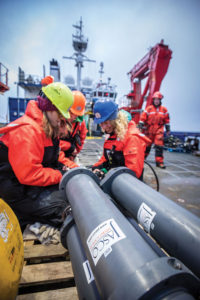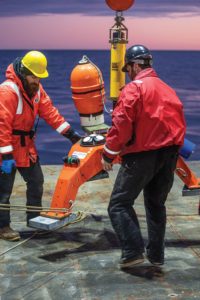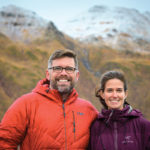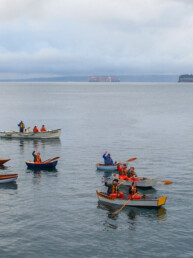Researching ice and waves aboard the Sikuliaq
Before the summer of 2018, spending time in the Arctic had never been on my radar. I really like the sun, I don’t like wearing shoes, and my hands get cold much too easily. But last year, during the three months I spent above the Arctic Circle aboard the 60’ sailboat, DogBark! on an attempt to transit the Northwest Passage, I could feel myself falling in love with the magical landscape and captivating variability. When DogBark! couldn’t push forward any further and had to turn back, I was crushed. But by then, I also knew it would not be my last time in Arctic waters; I was confident I would find a way to return one day.
I had no idea just how soon that day would come. Only 14 months after sailing away from the long summer days of Nome, Alaska, on a 4,000 mile journey bound for Hawaii, I found myself back in Nome, this time on a dark frosty evening in November. Instead of a 60’ sailboat with Northwest Passage ambitions, this time my husband, John, and I would be embarking on a month-long science expedition aboard the 261’ polar class research vessel, the Sikuliaq.
I am not a scientist, but I am a storyteller, and there is a great need for more stories about the work scientists are doing to understand this crucial and dynamic environment. We were there to observe and record the details while these scientists battled snow and cold and capricious equipment to gather measurements and observations that might move the needle—just a little bit—on our understanding of the elements at work in the Arctic.

Dr. Jim Thomson, an oceanographer in the Applied Physics Lab at the University of Washington, wants to better understand the role of waves in the Arctic and how they are impacting ice formation and shoreline erosion. He arranged this expedition, coordinating with 25 other scientists to spend a wintry month in the Chukchi and Beaufort Seas, to study conditions during the crucial fall freeze up, when the ice forming along the coast enters a battle with waves being generated in too much open water by large autumn storms.
The arctic environment is changing more rapidly than anywhere else on earth. The sea ice is forming later and melting sooner. The dense and durable multi-year ice is disappearing rapidly and not being replaced. It is well known that heat plays a big role in ice loss (warmer air and warmer water equals less ice), but the impact of waves has been more or less overlooked as a variable. Historically, this wasn’t part of the equation because waves rarely penetrated into the thick year-round ice in the Beaufort Sea. But now, contemplating the impact of waves is a crucial aspect of understanding the complex web of interactions in this “new Arctic.”
With less ice in the western Arctic, there is more fetch —more open water for waves to build in size and strength. Jim wants to understand what happens when these bigger waves encounter a shoreline historically protected with shore-fast ice. His hypothesis is that without the expansive ice cover, there might be a new positive feedback loop: big waves break up ice; with less ice, there is more fetch and the waves can grow bigger; bigger waves break up even more ice, which causes even more fetch and allows the waves to grow even bigger. The concern is that if these heavy seas break up and dissipate the shore-fast ice, it will leave the coast unprotected, accelerating coastal erosion.
(As a side note, this is called a positive feedback loop not because it’s a good thing, but because a small effect triggers changes that add to or exacerbate the original effect, in contrast to a negative feedback loop in which the reaction to an effect reduces or counteracts the original effect. And there’s your science lesson for the day.)

To understand the mechanisms of these wave/ice/coast interactions, Jim and a team of scientists employed the Sikuliaq to position themselves along the north Alaskan coastline where the shore-fast ice was trying to form and consolidate while late autumn storms drove heavy seas at the coast. He collected data using a variety of techniques, including autonomous buoys topped with an array of sensors, self-sufficient long-term moorings, and a month of human observation. This data, once analyzed and synthesized, can be incorporated into prediction models so that scientists can more accurately forecast the conditions in the Arctic in the coming years and decades.
It seems like a small thing, but it is daunting and urgent work. Some scientists have projected that within our lifetime we will see a runaway arctic melt, when the entire Arctic becomes ice-free during the summer. A positive feedback loop, like this one linking waves and ice, could contribute to a runaway event like that. It feels discouraging, but knowledge is power. The scientists aboard the Sikuliaq believe that if we can understand the problem and its context, we can work towards a solution, or at least towards mitigation strategies. We can figure out how to adapt and move forward confidently in this changing environment. Each observation and measurement add to our collective understanding of this rapidly transforming environment.
There is remarkable scientific research happening all the time, like the work Jim is doing; but very little of it reaches the public’s ears, beyond a few dramatic headlines about starving polar bears and rapidly melting ice caps. It is frustrating that their work goes unnoticed; these scientists are working on the front lines, anxiously watching dramatic changes take place right before their eyes, while much of the public goes about their day unaware of this urgency.

As the outreach team, John and I want to share the story of this one small effort to shine light on the fact that there are thousands of these small efforts all over the world, each one adding to the knowledge we have of this beautiful planet we inhabit. We want more people to understand and appreciate the effort required to trek to the ends of the earth for a single elusive data set. We want the public to see that there are people working tirelessly to gather the knowledge that gives us the power to make changes. That is why we shivered through negative temperatures, lurched through the boat in double digit swell, and worked through the long dark days of November; all in the name of science.
Learn lots more about the important work being done on the Sikuliaq at the website Becca and John maintain to share the stories and discoveries of the research: iceinmortion.com
Becca Guillote
Becca Guillote and her husband, John, are young Seattle-based cruisers exploring the world aboard their Valiant 40, Halcyon. After a massive 2019 that included their first Pacific Crossing, they temporarily decommissioned Halcyon in the Marquesas to pursue some short term opportunities to refill the cruising kitty including work on the Arctic Ocean R/V Sikuliaq (www.iceinmotion.com). You can follow their adventures at http://halcyonwandering.com/






